Cinematic Projections Beyond the Dance Floor: An Interview with Sonya Stefan
By Clint Enns
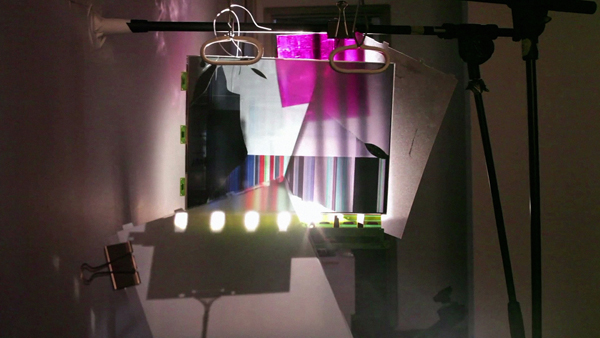 LCD Teardown / Sonya Stefan
LCD Teardown / Sonya Stefan
Sonya Stefan is a media artist who uses glitchy electronics, Hi-8 video, and 16mm film to create multimedia performances. Her work often transforms the damaged and discarded – from broken mixers and cracked LCD screens to a collection of found, disintegrating films – into contemporary media works. Many of her projects are collaborative and involve pillaging garbage bags full of abandoned 35mm film which she freely distributes to other local artists to work with.
In her most recent work, Stefan broadcast moving images onto 24 pulsating tube-televisions of various sizes in contemporary dancer Dana Gingras' anOther (2018), a collaboration between Gingras, Stefan, and Japanese avant-gardists Group A (Sayaka Botanic and Tommi Tokyo). In the piece, Gingras, wearing a black, form-fitting latex suit, emerges from a shiny cocoon after four televisions are ritualistically turned to face the center of the room by an alien-looking figure (Stefan). Group A are seen wearing lab coats in the background in their own enclosure (reminiscent of a television screen), figuring them somewhere between scientists and DJs. Sonically, they create unsettling drones that eventually transform into a throbbing dance beat one might hear while waiting in line outside of their favorite dance club. The screens display distorted and deconstructed images including Isabelle Adjani's iconic subway meltdown scene in Andrzej Żuławski's Possession (1981), scenes from David Cronenberg's Videodrome (1983) and close-ups of lips with colors reminiscent of Pipilotti Rist's work, all drenched in the strobing glow of television static. Gingras' dance transforms Adjani's gestures into a pained, yet cathartic, trance. The ritual ends in the dancers' exhaustion, and the four television screens are once again turned towards the audience before being shut off. A ritual performed in the age of the mediated image: long live the new flesh.
Stefan is a cofounder of la lumière collective, a microcinema in Montréal and the space in which we conducted the initial fragments of this interview. It has been collaboratively edited into its present form.
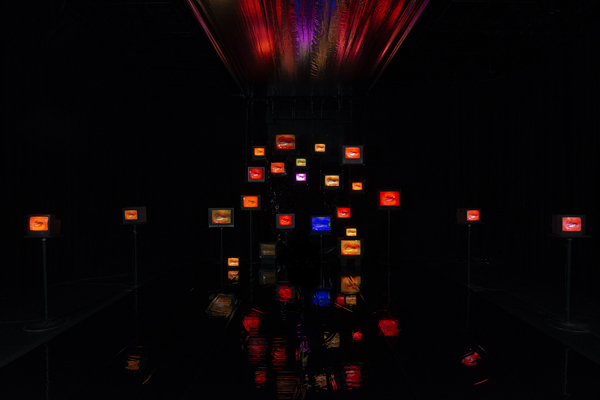
anOther Performance / Photo: Paul Litherland
Clint Enns: You began as a dancer and evolved into a media artist. How did this transformation occur? Do you still consider yourself a dancer?
Sonya Stefan: Although my background is in dance, I don't really identify as a dancer at this point. Working as a dancer means being submissive. For a dancer to create their own practice, they also have to be a producer, choreographer, and media specialist leading to a multidisciplinary practice that isn't necessarily better, just more work. As a dancer you are always at the mercy of a choreographer, in spite of the fact that everyone talks about collaboration. Collaboration in dance is never really collaboration; lately, I have been questioning and working through the power dynamics of collaboration in general. In dance, there are so many unwritten rules that dancers implicitly follow, leading to work that feels insular, conservative, and hermetic. I had enough.
After many years of dance training where I was told that I shouldn’t have an opinion, I finally separated myself from my training and began making my own work. At one point, I needed a change so I applied to the Mel Hoppenheim School of Cinema [Concordia University]. I was always interested in making films – as a child I made 16mm films and Hi-8 videos with my family – and eventually began taking black and white photographs that I would develop myself. I was divorced and had a young child, so this was how I spent my evenings: doing photo experiments.
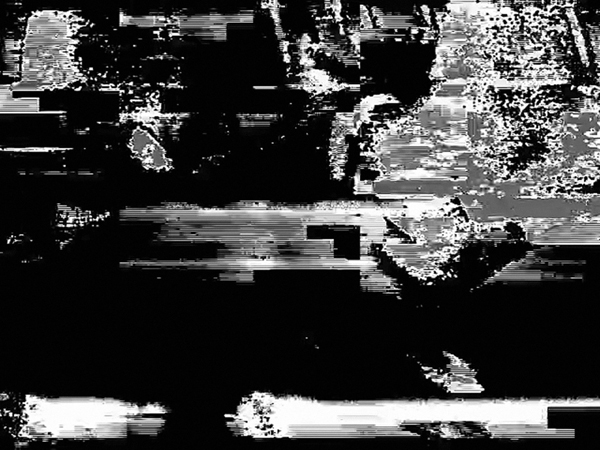 Roller Skating is for Old People / Sonya Stefan
Roller Skating is for Old People / Sonya Stefan
Narrative cinema has rules similar to dance (and often the same power dynamics), so I gravitated towards experimental artists. The first experiment I did was with a surveillance camera on my body. I rollerbladed in circles at Édifice Jean-Pierre-Perreault while doing the Limón technique, one of the basic movement techniques that every dancer learns. The work is called Rollerskating is for Old People (2009). The work is super glitchy with glorious color and inverts the relationship between filmmaker and dancer by placing the camera on the dancer as opposed to pointed at them.
Enns: Your found footage project Two-Hour Film (2011-ongoing) further disrupts the traditional power dynamics of filmmaking through collaboration and sharing. The project is based around a found 35mm Russian propaganda film called Histoire de ma Ville. Since that time, the film has been displaced from its cans and into garbage bags which you have publicly exhibited in various forms including: a slow-moving microfiche performance titled Passé Composé (2018), a collaboration with lyrical filmmaker Emma Roufs and musician Merganzer (Mika Posen); various live AV performances including those with Black Givre (Samuel Bobony); a backdrop for Ballet Divertimento; photographic prints; a collaborative loop with Guillaume Vallée titled The Ghost (2013); filmic earrings created by Alexandra Knowles; as filmic sculptures; and even as a lasso. How did you come across this footage?
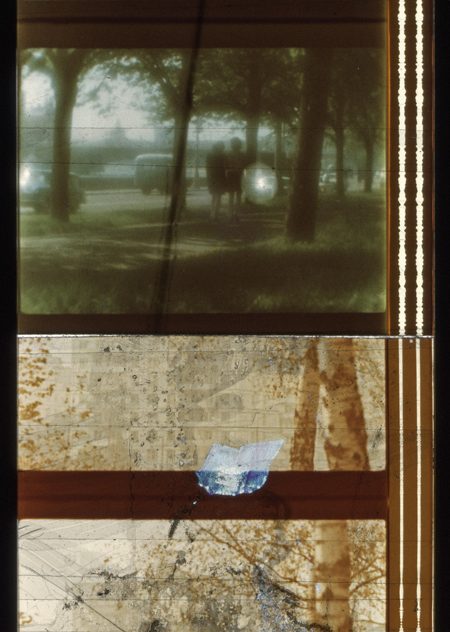
Passé Composé (detail) / Sonya Stefan
Stefan: I showed up to purchase a Steinbeck at a garage sale advertised on Kijiji. Experimental filmmaker Jean Bourbonnais arrived at the same time I did. He was scruffy, had these big eyes, and was wearing a grey suit. He wanted the machine for La Passe [an underground space in Montréal]. We both tested it; however, the owner told us that he would call us the next day to announce whom the machine would go to. The next day he called and said he gave it to Jean (because he was a filmmaker) but that I could have this documentary film if I wanted it. I returned with a dolly and took the cans home. In my apartment, I released the film from its cans, unreeling them into piles on the floor.
Enns: In one dance piece, Salon-Double (2013), you transform the film into a shower.
Stefan: Often the film acts more as an object, or sound source. That is, I treat it simply as a physical object as opposed to a moving image medium. In Salon-Double, it made such an incredible sound as it poured down like water from the rafters. The movement of film is very much like the movement of a body, the way it curves. The piece, in general, is a reaction to the perceived preciousness of filmic objects. It is placed in garbage bags and poured out onto the floor. By unreeling it, it becomes totally messy and unwieldy, but also open to chance, both in the way the image is destroyed and the ways in which one finds images in the footage. Once the film has hit the floor, it will never be in a “perfect” state again.
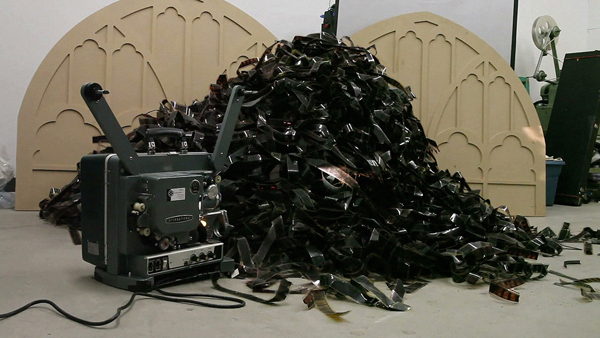 Two-Hour Film / Sonya Stefan
Two-Hour Film / Sonya Stefan
Enns: When it comes to the footage itself, how do you select the images you will use?
Stefan: For The Ghost there was no real conversation on how to select the images, we simply stuck our hands into the garbage bags and randomly pulled out images. The first images that we took were of farmers and Leonid Brezhnev. We started to make this crazy-glue film but never finished it. We have created single images from it, and a loop that we often use during live performances, both when we perform together and alone. I used the loop for the backdrop for Ballet Divertimento and it was used in the performances I did with Black Givre. The Ghost was more of a gateway to other works than a finished piece.
In contrast, when I worked with Emma on Passé Composé, we wanted to make a work that removed all elements of war and violence from the original images. We wanted to subvert the original work by showing men who are sensitive and caring, women who are free (for instance, not working in a factory), and nature. The final piece was two hand-spliced rolls of film which we slowly ran through microfiche projectors. We each worked on our own rolls, but we edited side-by-side and would often share images with each other. Emma was really attracted to the film's previous life (all of the scars and defects) without knowing its history. We performed the projection at Mirror Mountain Film Festival with live music by Merganzer.
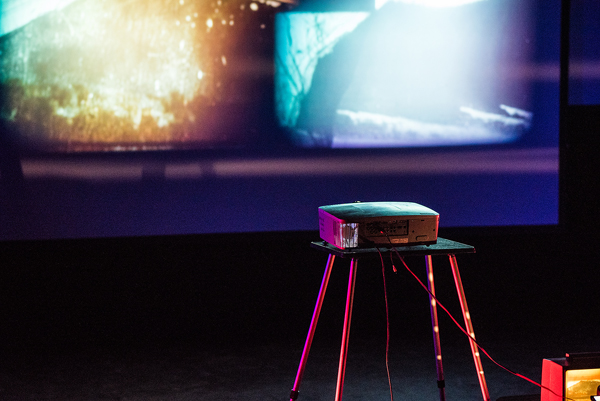 Passé Composé Performance / Sonya Stefan
Passé Composé Performance / Sonya Stefan
Enns: Two-Hour Film seems to embody the methodology of your artist practice. That is, it demonstrates the ways in which you embrace the unexpected and the imperfect and some of the ways in which you navigate the chaotic. Can you talk about this methodology in relationship to your other work?
Stefan: In my dance practice, I used a task-based procedure, that is, a set of rules that framed your behavior or choice-making. The tasks were required, but whatever else happened while performing was created in the moment. Performing these tasks meant you had to become comfortable with failure given the near impossibility to perform any task perfectly and the potential for everything to fall apart. In Fishbowl Experiment (2013), my friend, contemporary dancer Audree Juteau, and I worked with her dog Sam, who ultimately determined what happened during the piece. Sam wasn’t a hyper dog, so we had to be patient as we watched her make choices. Using two GoPro cameras and a split screen, once again from the performers' perspective (similar to Rollerskating), I tried to capture the affect between the performers, Sam and Audree, both physically and through other gestures such as eye contact.
Enns: Do you see your work in relation to the strong glitch art movement of the recent past?
Stefan: I got into glitch art when I started following artists on Facebook through a glitch group. The group was very open to sharing their methods and to providing constructive critique. At least to me, it felt like experimental cinema had migrated from the black box to the web. The first time I realized there was a difference between the way cinephiles watch films and the way regular people watched movies was in a "moving camera" course with Peter Rist. My ex-boyfriend would tap me on the arm every time I shifted in my seat, a reminder that this was a quiet space. I would often spend more time managing my impulse to move than watching the film. The time spent in the cinema made me feel a "lost" sense of time. In a screening, you disassociate with your body. Up until that point, I spent most of life within my body. The web offered me the opportunity to engage with work on my own terms. The aesthetic of the web also appealed to me enormously: the variety of images being produced, the sharing of techniques, the escape from the pretentiousness of the experimental film community. People were engaged, and actively engaging. It felt as though I was part of a movement in the making.
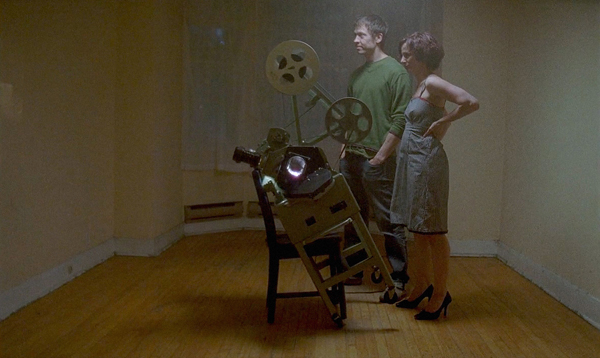 Brian Virostek's converted Moviola projector
Brian Virostek's converted Moviola projector
I also like the aesthetics of works that are on the brink of falling apart. For instance, in collaboration with Brian Virostek, I created loops for a 35mm Moviola editor that he converted into a projector. To use the machine, you have to rest it on two of its four legs. The machine is super heavy and every time you want to use it, you must perform this intense action that almost evokes the same feeling you get when you watch a child attempting to balance on the back two legs of a chair.
Enns: Virostek's converted Moviola projector inverts the cinematic appartus, whereas your piece LCD Teardown (2016) literally deconstructs it. How did this work come about?
Stefan: I was invited to Art Hack Day at Eastern Bloc where I met Stephanie Castonguay [Perte de Signal]. At the time, I wanted to take an LCD screen apart to find out how it works, and Stephanie was into it. We went to a thrift shop to purchase the screen, and with the help of Raphael Demers and a YouTube tutorial, we took it apart and lit it using a 16mm film projector. It became a hybrid object with the broken images displaying the tutorial.
Enns: Can you talk about some of your collaborations with musicians? Is this similar to working with dancers or with visual artists?
Stefan: Performing live with sound artists and musicians is the exact opposite of cinema and dance, in which you prepare and perfect your work for long periods before showing it. Sometimes you only have one conversation with musicians before you go on stage and perform with them. It is in the moment and it has the potential to fail, which is exciting, and allows you to see failure from a different perspective.
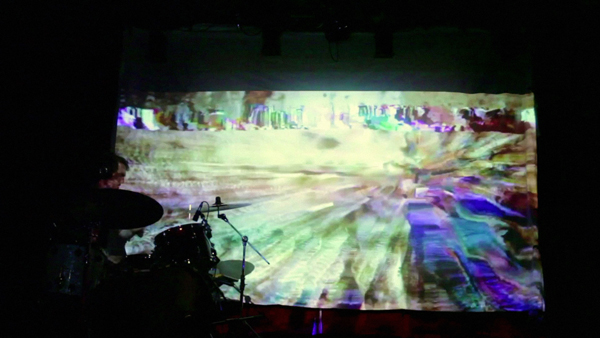 Sonya Stefan and Black Givre Performance
Sonya Stefan and Black Givre Performance
Two of the musicians I work with, Alain [Lefebvre] and Sam [Black Givre], are ex-boyfriends. Alain and I decided that we should make a video every month, under the project name Annuaire. Every month, we came up with an idea and went with it. I liked the short-term process. That year, I tried everything – film, glitch, video, and hybrid forms. We even switched roles for two of the months. August’s Garden of the Dead (2013) was filmed off Virostek's converted Moviola and bleached by Alain. I did sound for September’s 13/i (2013), which was basically my iTunes playlist. I set the time from shortest song to longest and created a sound collage that encompassed the sounds of my life up until that moment. Oct/13/puss (till I die) (2013) was created using a glitching VLC player.
With Sam, the process was different. The first time I met him he was playing at the Bistro on rue St. Denis. The way he played drums felt like he was out of control which, of course, I loved. He also made these crazy faces. We first performed live together at a Jeunesse Cosmique event at Casa del Popolo in 2014. That was the first time I performed live with a television. With Sam, I felt like I could try stuff out, but we would often return to working with televisions and video feedback.
I shouldn’t collaborate with boyfriends anymore, it’s too complicated.
Enns: The Elmo Show (2013), one of the pieces created as part of Annuaire, feels super intimate. The way the saturated image is slowed down makes it feel almost sensual. Why sensual Elmo?
 The Elmo Show / Sonya Stefan
The Elmo Show / Sonya Stefan
Stefan: I don’t think Elmo is sensual. It is like he is trying to directly communicate something to you, like in a dream. I would often watch an Elmo VHS with my daughter. When you have children you often watch things over and over again, relentlessly. I loved the intimacy in that Elmo tape and I loved how colorful it was. I wanted to slow Elmo down since he has such lovely, caring eyes and these warm gestures. Alain and I were performing at Mutek, so I thought it would be nice to bring Elmo. It was intended to be playful.
Enns: One of your more recent works, anOther, involved 24 television screens. As part of the climax you deconstruct the subway scene from Possession, which seems to inform Gingras' movements. How did you choose this scene? Was it due to the fact that the scene is iconic or was it because of how visceral the scene is?
Stefan: Dana proposed the scene and we watched the film at her house. It was my first time seeing it. I was embarrassed by Adjani’s behavior in that scene and had no idea how I was going to work with it. I didn’t know where to start. At first I tried removing her from the scene, to simply look at the space and ease my embarrassment. After having conversations with Dana, and after reading Kier-La Janisse's House of Psychotic Women and Barbara Creed’s The Monstrous-Feminine, my perspective began to shift. I came to see hysteria as a strength rather than a weakness; as a form of feminine empowerment. I began treating the footage in different ways: using Facebook to glitch it; passing the images through VCRs and Hi-8; re-photographing TV screens. As Adjani’s expressions externalized the internal, I was internalizing the external. I tried to distance myself from the emotional state and look at her body as a vessel.
I come from a family with hysterical women. My parent’s marriage was arranged – and they were totally different. He was from Northern Italy, she was from the South. My mother would have outbursts that stopped the whole family (and whoever happened to be around) in their tracks. From overdoses, public shaming, furniture smashing, car wrecking, to love affairs with the family’s best friends... it was a daily undertaking. I now realize that it was her method of changing her circumstances, of being empowered. We did a mother-daughter trip to Calabria and the first question everyone asked us was “where are your husbands?” She would have an outburst and people would back away. She was in control.
The movements in video can also be seen as a having their roots in a form of Tarantism, a folk dance which comes from Calabria in which a hysteric woman goes into a trance to cleanse herself, to shake out the trauma. The Tarantism was a town event – it was a ritual that everyone accepted and, in some way, participated in. The idea was that shaking one's body could dislodge memory from your organs/tissues. Adjani’s subway scene offers a different reading of the body since it unapologetically demonstrates emotional excessiveness or hysteria. Looking at emotional excessiveness made me feel embarrassed; however, like the Tarantism ritual, maybe it is way to release trauma.
Enns: The performance reminded me of a night at the club gone wrong. Like Group A as club DJs complete with lab coats (a trope of the rave scene). The strobing effect of the televisions and the intensity of the music created a form of sensory overload. Was there an intentional connection between the work and club culture? Moreover, it’s not uncommon to see scenes from Videodrome on monitors at noise shows given its cult status (especially in Toronto).
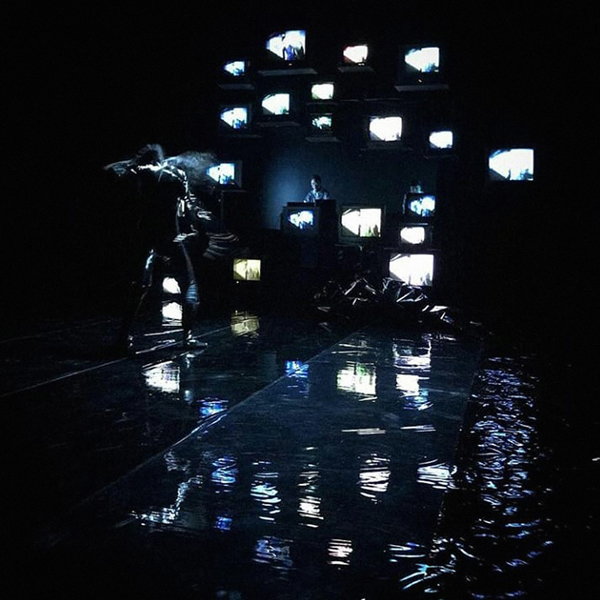 anOther Performance / Photo: Paul Litherland
anOther Performance / Photo: Paul Litherland
Stefan: I love late night television from the 1980s and 90s. I especially love the locally created content. I wanted the screens to resemble late night cable television. I wanted them to have their own life force. I also wanted the televisions to be directly connected to the overall piece, not simply a backdrop. Each television was an individual dancer in conversation with Dana or Group A, like energized bodies. I saw them as a “corps de ballet,” becoming a group that would meld into the space. None of the televisions were color corrected and each came with its own personality and defects. One of the larger televisions even had an entire section that was burned out, creating these beautiful colors. It was, of course, my favorite, becoming a soloist due to its imperfections! The televisions acted both individually and together.
Enns: Setting up 24 controlled analogue tube-televisions must have been a logistical nightmare. How did you manage?
Stefan: I have some photographs of the cord arrangement. It is similar to the way cords are set up in India. I was on tour there with the Toronto Dance Theatre, and I remember one of the theatres where the cords were a total mess, which one of the dancers, Michael Trent, grimaced at. During that show, all the lights accidentally went off, except for a small one directly on his face. You could only see his eyes. It was hilarious and kind of perfect. Our precious dance piece was overtaken by the “bad bad messy cords.” There was confusion; no one knew what to do. But then the lights came back on and we continued. In fact, it was better, less stiff. It felt as though we were awakened by the mistake. I could feel everything: the space, the people, the thoughts, and none of us knew what was going to happen. It was invigorating. There should be more opportunity for error; this stuff shouldn't be perfect. Messiness and imperfection are part of what makes performance exciting, for the audience and for the performers.
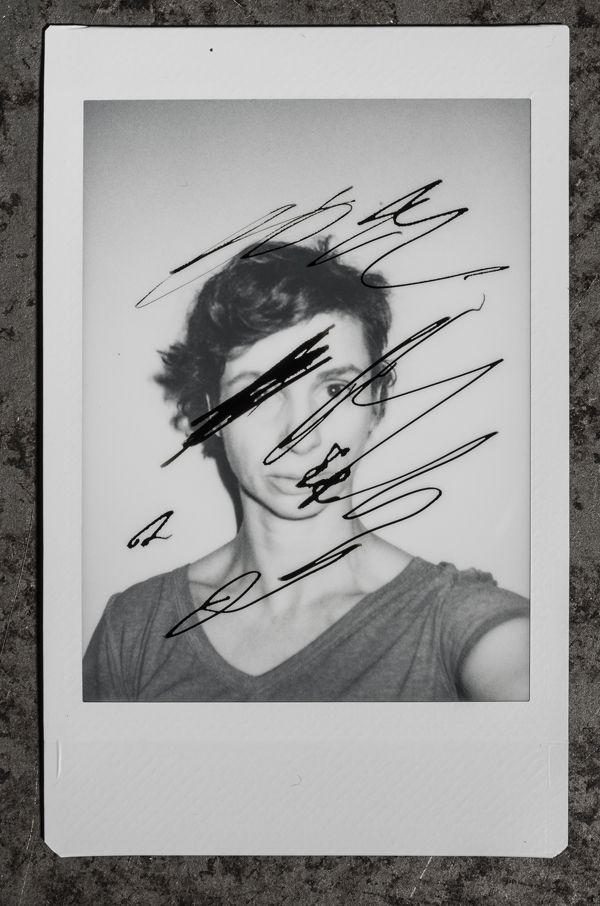
Sonya Stefan / Photo: Yannick Grandmont
Published December 4, 2018
ABOUT THE AUTHOR
Clint Enns is a visual artist living in Toronto. His work primarily deals with moving images created with broken and/or outdated technologies, and has shown both nationally and internationally at galleries, festivals, alternative spaces, and microcinemas. He has a Master’s degree in mathematics from the University of Manitoba, and a Master’s degree in cinema and media from York University where he is currently completing a PhD. His writings and interviews have appeared in Leonardo, Millennium Film Journal, INCITE: Journal of Experimental Media, BlackFlash, and Spectacular Optical.
